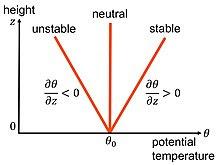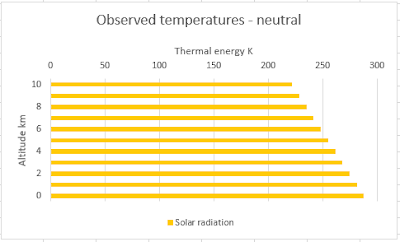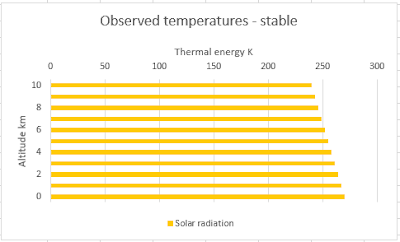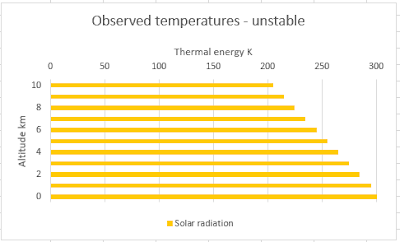From the motherlode:
The greenhouse effect works like this: Energy arrives from the sun in the form of visible light and ultraviolet radiation. The Earth then emits some of this energy as infrared radiation. Greenhouse gases in the atmosphere 'capture' some of this heat, then re-emit it in all directions - including back to the Earth's surface. Through this process, CO2 and other greenhouse gases keep the Earth’s surface 33°Celsius (59.4°F) warmer than it would be without them.
(This also means that the upper layers will be cooler than they would have been, they only mention that as an aside).
Proper physics is beyond them, but they don't even have a grasp of the weather forecasters' concept of Potential Temperature. That article is recommended reading. They show it diagrammatically as follows:

Remember - if the lapse rate is 6.6 C/km, then air which 1 km up and has an actual temperature of 25C has a potential temperature of 31.6C. If air at ground level has an actual temperature of 31.6C, then the two layers are in a neutral situation.
Neutral
If the air has the following pressure-altitude profile, where the absolute temperature falls by 6.6C for each km of altitude (the observed lapse rate), it is in a neutral situation. Each layer of air is the 'right' temperature for that altitude, and no layer particular wants to move up or down:

Stable
If the air higher up is warmer and the air lower down is cooler (relative to the neutral situation), this is a stable situation. The warmer air is quite happy where it is, the cooler air is quite happy where it is. But this situation does not hold for long, because the lower layers will warm up and the higher layers will cool down (see article), re-establishing the neutral situation:

Unstable
If the air higher up is cooler and the air lower down is warmer (relative to the neutral situation), this is an unstable situation. The cooler air will sink and the warmer air will rise until the neutral position is re-established:

Why we can pretty much ignore CO2
We know that CO2 in an enclosed glass container in sunlight will warm up a bit more than normal air. This is because CO2 absorbs slightly more of the infra red, and more importantly, because it has a lower specific heat capacity, i.e. it takes less energy to warm CO2 by 1C.
The Alarmists say that having 'trapped' the warmth near the surface, the air lower down will be warmer and the air higher up will be cooler than it otherwise would be (loft insulation makes your home warmer and the loft space cooler).
OK, that's superficially plausible. But to believe that, you must also believe that air is locked in position, and that the warmer air near the surface (and the cooler air higher up) will just stay where it is.
You have to believe that infra red energy can bounce around in a certain volume of space and influence temperature regardless of how the medium which 'trapped' it behaves. This is supposed to be about Global Warming, i.e. temperature changes, so why don't we look at actual temperatures of actual things and see where they go, what they do?
Well of course the warmer air won't stay just hovering above the surface and the colder air higher up won't stay higher up. We now have an unstable situation. The warmer air will rise and the cooler air will fall, it all gets mixed until we are back in the neutral situation again. This will happen at the same time and at the same rate as any 'surface warming' and the two processes constantly cancel each other out, with no overall effect on surface temperatures.
* Clearly, if there is more CO2 in the air, the lapse rate will increase slightly (lapse rate = gravity ÷ specific heat capacity), warming the air at the surface and cooling the air higher up. But bearing in mind we are talking about an increases in CO2 levels of about 0.01% per century, the increase in the weighted average lapse rate is going to be immeasurably small. And we know that water and water vapour will moderate that even further.
